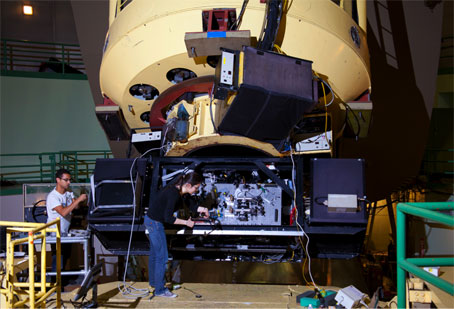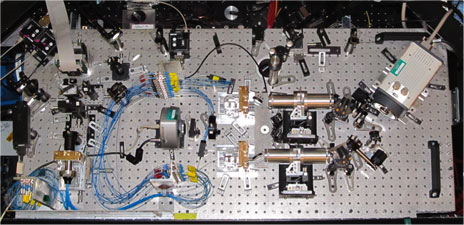
Every ground based instrument is subject to the deleterious effects of atmospheric turbulence : telescope images are affected, leading to a lowering of the effective resolving power of the instrument (the capacity to distinguish very close objects), and to a degradation of the image dynamics. The dynamics (also referred to as the « contrast ») is a measure of the ability to distinguish a weak source of light next to a bright one ; a wide dynamical range is an essential prerequisite for the detection of dim companions, such as exoplanets, close to their parent stars.
FIRST, an inovative principle
The principle of the FIRST instrument is based on the combined use of single mode optical fibres, commonly used for telecommunications,, and the aperture masking technique, in order to restore the theoretical performance of the telescope. Atmspheric turbulence tends to destroy the coherence of light rays reflected from different parts of the mirror, but the optical fibres enable one to select out just those rays which are nevertheless still coherent, and to transport them to a detector on which interference fringes can form, free of the deleterious effects of atmospheric turbulence. The information about the spatial structure of the source (e.g. the separation and the brightness ratio of two neighboring stars) is contained in the contrast and the position of these interference fringes.
Once the concept was demonstrated in the LESIA laboratories, FIRST was successfully integrated in July 2010 into the Cassegrain focus of the Lick Observatory’s 3m Shane telescope by an international team including scientists not only from the LESIA, but also from Berkeley University, from the SETI Institute, from the Japanese Astronomical Observatory, from the Canada-France-Hawaii telescope and from the W.M. Keck Observatory.
This 3 m telescope has an adaptive optics system which enables the telescope to reach its diffraction limit at infra-red wavelengths. By combining this system with the FIRST instrument, the theoretical performance of the telescope can be reached in the visible domain, where adaptive optics is somewhat less efficient.
Steps towards the study of faint companions
Data acquired using FIRST at the Lick Observatory have enabled the two components of the binary system of Capella to be separated. Capella is the brightest star of the Auriga constellation ; it is 43 light years from the Earth, the two stars of the binary system turning around each other, separated by a distance on the order of that between the Sun and Venus.
As well as giving accurate, diffraction limited measurements of the stellar positions, leading to a determinatin of the orbital parameters of the system, FIRST has produced a novel determination of the brightness ratio of the two stars, in the spectral range from 600 to 850 nm : this constitutes new and quite unique information which helps to characterize the two stars. The spectra can in effect be analyzed and compared to stellar models, and hence obtain the physical parameters, such as the temperature, of each star, as well as their metallicity and their surface gravity. A comparison of the data with the latest models has highlighted the latter’s weakness in certain molecular bands.
A new version : FIRST-18

Wide dynamic imagery is a rapidly expanding and developing technique. The current version of the instrument, the subject of Elsa Huby’s thesis, is called FIRST-18, since it enables light sampled from 18 parts of the main mirror, each 40 cm in diameter, to be recombined. The dynamical range of the instrument increases with the number of samples which are recombined, as well as with the measurement accuracy, which is a function of the stability of the instrument.
To date, FIRST-18 has led to the detection of a companion which is several hundred times fainter than its central star. Following up on these first results, the dynamical range of the instrument will need to be improved by a factor of between 10 to 100 in order to be able to detect planetary companions very close to their parent stars. Work is in progress to achieve this target.
FIRST-18 has recently been integrated into the adaptive optics platform of the new generation 8m Subaru telescope in Hawaii. The more stable environment and the better adaptive optics setup will increase the sensitivity and the dynamical range of the instrument. Moreover, since its mirror is 2,7 times larger, this telescope has a 2,7 times better angular resolution than the 3m Lick Observatory telescope.
FIRST-18 at Subaru received its first stellar photons in July 2013, thus clearing the way to the observation of tightly bound stellar systems, as well as to the study of the surfaces of evolved red giant and super giant stars, in order to investigate their superficial convection.

